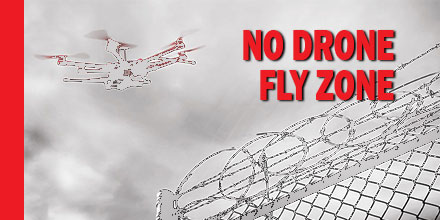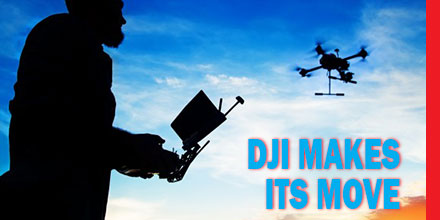
Call it the ultimate No Drone Fly Zone.
On Aug. 4 the Department of Defense (DoD) released classified guidelines for military personnel. The guidelines focused on available actions in the event of unauthorized drone intrusion over or around a military installation.
The Federal Aviation Administration (FAA), along with other inter-agency partners, helped develop the guidelines. It follows classified guidance that was previously provided to the services and installations in early July.
“Protecting our force remains a top priority and that’s why DoD issued the specific, but classified policy that details how DoD personnel may counter the unmanned aircraft threat,” said United States, Navy Capt. Jeff Davis.
A growing concern?
According to a Pentagon spokesman, the guidance is to help address growing concerns around safety and security of military installations, aviation and people.
And, certainly, drone use continues to explode across both recreational and commercial sectors.
The FAA predicts the number of hobbyists will increase to 355 million by 2021. Commercial drone users are expected to increase to 442,000 during that same time period.
Of course, all drone operators must adhere to FAA regulations and guidelines. Any flight operated beyond these regulations is considered unauthorized activity.
In April, the Pentagon and FCC announced a new rule which prohibited any drone flights within 400 feet of 133 domestic installations. Pilots caught violating the restriction were subject to arrest. However, that announcement did not mention any direct action the military could take to destroy or intercept the drones.
Tracking, disabling, destroying
If an unauthorized drone flight intrudes into military airspace, DoD personnel now have guidelines in place to respond to the threat.
Authorized actions include: tracking, disabling and destroying drones. Of course, the authorized action depends on the circumstance and the type of installation where the drone activity is detected.
“We support civilian law enforcement investigations in the prosecution of unauthorized UAS operations over military installations,” Davis said. “And though we do not discuss specific force-protection measures, we of course retain the right of self-defense. When it comes to UAS or drones operating over military installations, this new guidance does afford us the ability to take action to stop those threats.”
Drone operators can find additional flight regulation information at the Know Before You Fly website.
Before these guidelines, the military could take action to intercept a wayward drone. Those options included use of traditional ammunition to destroy the craft all the way to commandeering them via radio waves. In addition, intercepted crafts were subject to seizure “as part of investigations,” said Davis.
So, wayward flyers beware, intruding over or around any of these 133 installations could result in the loss of your craft.
 The power to extend flight time while in the field just got a little easier thanks to Colorado Drone Chargers.
Formerly known as P-Squared Group, Colorado Drone Chargers is a leading designer and manufacturer of rapid charging systems for unmanned aerial vehicles.
The company focuses exclusively on charging technology and ease of use for the customer.
The complete line of Portable Rapid Charging Systems (PRCS) is now available at Unmanned Systems Source.
“Our mission is to make and market the best products,” said Johnny Podrovitz, founder of Colorado Drone Chargers. “From day one, we have been committed to delivering exceptional products for the drone battery charging industry.”
The power to extend flight time while in the field just got a little easier thanks to Colorado Drone Chargers.
Formerly known as P-Squared Group, Colorado Drone Chargers is a leading designer and manufacturer of rapid charging systems for unmanned aerial vehicles.
The company focuses exclusively on charging technology and ease of use for the customer.
The complete line of Portable Rapid Charging Systems (PRCS) is now available at Unmanned Systems Source.
“Our mission is to make and market the best products,” said Johnny Podrovitz, founder of Colorado Drone Chargers. “From day one, we have been committed to delivering exceptional products for the drone battery charging industry.”

 NuWaves Engineering announced the completion of the IRaD phase for their newest miniaturized 10 watt C-band bidirectional amplifier (BDA). This product adds to the existing line of NuPower Xtender bidirectional amplifiers.
Currently, plans are to price this at $2,900/ea in quantities of one hundred. It is available Q4 2017. NuWaves is an international Radio Frequency (RF) and Microwave solutions provider.
NuWaves continues to push their presence and expertise to higher-frequency applications. The NuPower Xtender C10RX01 and C10RX02 BDA modules follow the release of the 20 W C-Band Power Amplifier (C20R01) and the 20 W C-Band bidirectional amplifier (C20RX01).
This latest BDA offers the performance of a traditional power amplifier coupled with a low noise amplifier for receive mode. It provides an amplification solution in one miniaturized package for half-duplex transceivers.
NuWaves Engineering announced the completion of the IRaD phase for their newest miniaturized 10 watt C-band bidirectional amplifier (BDA). This product adds to the existing line of NuPower Xtender bidirectional amplifiers.
Currently, plans are to price this at $2,900/ea in quantities of one hundred. It is available Q4 2017. NuWaves is an international Radio Frequency (RF) and Microwave solutions provider.
NuWaves continues to push their presence and expertise to higher-frequency applications. The NuPower Xtender C10RX01 and C10RX02 BDA modules follow the release of the 20 W C-Band Power Amplifier (C20R01) and the 20 W C-Band bidirectional amplifier (C20RX01).
This latest BDA offers the performance of a traditional power amplifier coupled with a low noise amplifier for receive mode. It provides an amplification solution in one miniaturized package for half-duplex transceivers.
 The StreamCaster 4200 (SC4200) radio by Silvus Technologies was recently selected by MILREM, a manufacturer of Unmanned Ground Vehicles (UGV) based in Estonia. MILREM will integrate the SC4200 onto the Tracked Hybrid Modular Infantry System (THeMIS) platform.
THeMIS UGV is an intelligence, surveillance and reconnaissance (ISR) platform. It assists with target acquisition, logistics support, and other missions.
The SC4200 serves as the datalink, providing wireless command/control and video. It pairs with high performance antennas to allow the THeMIS to drive extended ranges, and push video and data communication farther than before.
“Silvus is offering rugged and high quality MIMO radios which have proven to provide reliable wireless video and data communication over extended range,” said Rivo Opik, MILREM’s Chief Engineer. “The technical support and guidance from the Silvus team has been quick and very effective.”
SC4200 2x2 MIMO radio features transmit beamforming which nearly doubles the signal range. The ability to significantly extend range is why MILREM choose the SC4200 for the THeMIS. Companies purchasing the THeMIS can control, one, two or an entire fleet of these UGVs. In addition, users can monitor what is happening using a real-time, live HD-video feed from the Silvus radios.
The StreamCaster 4200 (SC4200) radio by Silvus Technologies was recently selected by MILREM, a manufacturer of Unmanned Ground Vehicles (UGV) based in Estonia. MILREM will integrate the SC4200 onto the Tracked Hybrid Modular Infantry System (THeMIS) platform.
THeMIS UGV is an intelligence, surveillance and reconnaissance (ISR) platform. It assists with target acquisition, logistics support, and other missions.
The SC4200 serves as the datalink, providing wireless command/control and video. It pairs with high performance antennas to allow the THeMIS to drive extended ranges, and push video and data communication farther than before.
“Silvus is offering rugged and high quality MIMO radios which have proven to provide reliable wireless video and data communication over extended range,” said Rivo Opik, MILREM’s Chief Engineer. “The technical support and guidance from the Silvus team has been quick and very effective.”
SC4200 2x2 MIMO radio features transmit beamforming which nearly doubles the signal range. The ability to significantly extend range is why MILREM choose the SC4200 for the THeMIS. Companies purchasing the THeMIS can control, one, two or an entire fleet of these UGVs. In addition, users can monitor what is happening using a real-time, live HD-video feed from the Silvus radios.
 That didn’t take long.
DJI, the Chinese-based company, took little time to address the gathering noise over cyber security concerns.
At the beginning of August, the U.S. Army called for troops to cease and desist use of DJI drones, equipment and cameras for any operations.
The Army's announcement seemed to catch DJI unaware.
In the last few days, DJI announced that it will accelerate the release of a new feature, Local Data Mode. This feature will be a part of the DJI controller app. When selected, Local Data Mode will allow pilots to disconnect from the internet during flights.
The update releases at the end of September.
“We are creating Local Data Mode to address the needs of our enterprise customers, including public and private organizations that are using DJI technology to perform sensitive operations around the world,” said Brendan Schulman, DJI Vice President of Policy and Legal Affairs. “DJI is committed to protecting the privacy of its customers’ photos, videos and flight logs. Local Data Mode will provide added assurances for customers with heightened data security needs.”
This feature is designed to stop internet traffic to and from DJI’s flight control application. This would make it “impossible” for the craft to communicate any flight log data, photos or videos with DJI servers. It would also prevent any accidental syncing with DJI servers.
DJI believes Local Data Mode offers users some level of data management. DJI hopes this feature will help alleviate privacy and security concerns for sensitive operations.
That didn’t take long.
DJI, the Chinese-based company, took little time to address the gathering noise over cyber security concerns.
At the beginning of August, the U.S. Army called for troops to cease and desist use of DJI drones, equipment and cameras for any operations.
The Army's announcement seemed to catch DJI unaware.
In the last few days, DJI announced that it will accelerate the release of a new feature, Local Data Mode. This feature will be a part of the DJI controller app. When selected, Local Data Mode will allow pilots to disconnect from the internet during flights.
The update releases at the end of September.
“We are creating Local Data Mode to address the needs of our enterprise customers, including public and private organizations that are using DJI technology to perform sensitive operations around the world,” said Brendan Schulman, DJI Vice President of Policy and Legal Affairs. “DJI is committed to protecting the privacy of its customers’ photos, videos and flight logs. Local Data Mode will provide added assurances for customers with heightened data security needs.”
This feature is designed to stop internet traffic to and from DJI’s flight control application. This would make it “impossible” for the craft to communicate any flight log data, photos or videos with DJI servers. It would also prevent any accidental syncing with DJI servers.
DJI believes Local Data Mode offers users some level of data management. DJI hopes this feature will help alleviate privacy and security concerns for sensitive operations.
 Call it the ultimate No Drone Fly Zone.
On Aug. 4 the Department of Defense (DoD) released classified guidelines for military personnel. The guidelines focused on available actions in the event of unauthorized drone intrusion over or around a military installation.
The Federal Aviation Administration (FAA), along with other inter-agency partners, helped develop the guidelines. It follows classified guidance that was previously provided to the services and installations in early July.
“Protecting our force remains a top priority and that’s why DoD issued the specific, but classified policy that details how DoD personnel may counter the unmanned aircraft threat,” said United States, Navy Capt. Jeff Davis.
Call it the ultimate No Drone Fly Zone.
On Aug. 4 the Department of Defense (DoD) released classified guidelines for military personnel. The guidelines focused on available actions in the event of unauthorized drone intrusion over or around a military installation.
The Federal Aviation Administration (FAA), along with other inter-agency partners, helped develop the guidelines. It follows classified guidance that was previously provided to the services and installations in early July.
“Protecting our force remains a top priority and that’s why DoD issued the specific, but classified policy that details how DoD personnel may counter the unmanned aircraft threat,” said United States, Navy Capt. Jeff Davis.
 The Duluth Fire Department in Duluth, Minnesota is considering purchasing the Emergency Integrated Lifesaving LanYard (EMILY) drone.
Hydronalix, located near Tucson, Arizona, created and manufactures the 24-pound unmanned water rescue vehicle.
The Duluth Fire Department in Duluth, Minnesota is considering purchasing the Emergency Integrated Lifesaving LanYard (EMILY) drone.
Hydronalix, located near Tucson, Arizona, created and manufactures the 24-pound unmanned water rescue vehicle.
